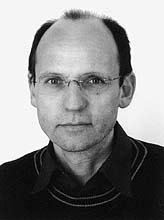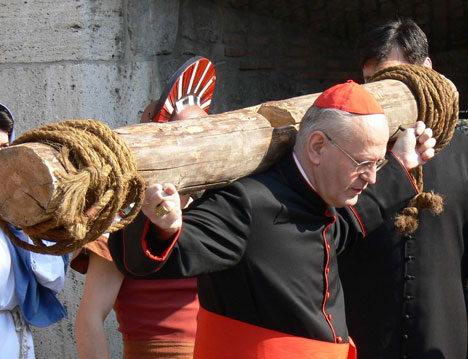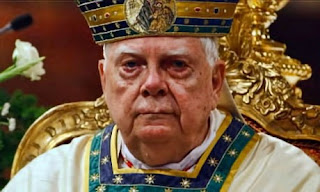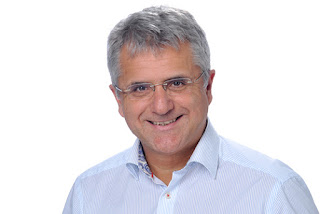Paderborn Cathedral organises artistic competition for sexual abuse memorial. A substitute for justice?
Exhibition featuring the designs of all participating artists at the Paderborn Diocesan Museum from 4 April 4 2025 / Jury and Artists / Winning design by Christoph Brech from Munich
Eight artists participated in the competition for the planned memorial in the area of Paderborn Cathedral, which addresses sexual and spiritual abuse in the church. A jury composed of representatives of the Archdiocese of Paderborn, the Metropolitan Chapter, the representatives of victims in the archdiocese, and internal and external experts reviewed the submitted designs and selected the winning design on Tuesday, March 25, 2025: The design by Christoph Brech from Munich was chosen. The artist's design recommended for implementation will be presented to the public, along with all other submissions, in the foyer of the Archbishop's Diocesan Museum from April 4 to May 18, 2025. Admission to the foyer exhibition is free.
The competition presented the invited artists with a special challenge: With their design for the future memorial and monument in the area of Paderborn Cathedral, they were to make clear that the Church recognizes, acknowledges, and regrets the failure of clergy and lay people regarding the sexual or spiritual abuse of those under its care, children, and dependents, and is committed to taking all possible measures to prevent this from happening again. This was the joint call for proposals from the Archdiocese of Paderborn, the Paderborn Metropolitan Chapter, and the representatives of victims in the archdiocese. The artwork is intended to visibly place the suffering of all those affected in the area of the cathedral and thus in the church of Paderborn.
A jury composed of representatives from the archdiocese, the Metropolitan Chapter, and the representatives of victims, as well as internal and external experts, has selected the artists' designs for a memorial and monument on sexualized violence to be created at Paderborn Cathedral. From left to right: Vicar General Dr. Michael Bredeck, Cathedral Canon Dr. Thomas Witt, Reinhold Harnisch, Dr. Holger Kempkens, Professor Dr. Christoph Stiegemann, Michael Heltner, Dr. Herbert Fendrich, Cathedral Provost Monsignor Joachim Göbel, and Professor Dr. Maren Ziese.
Jury decides
The jury members met with the artists participating in the competition in mid-March, who were able to discuss their submitted designs. In a second meeting, the jury members selected the winning design, which will be implemented. Members of the jury are Vicar General Dr. Michael Bredeck representing the Archdiocese of Paderborn, Cathedral Provost Monsignor Joachim Göbel and Cathedral Canon Dr. Thomas Witt representing the Metropolitan Chapter, Reinhold Harnisch and Michael Heltner from the board of the Association of Victims of Disasters in the Archdiocese of Paderborn, and the two internal experts, Dr. Holger Kempkens as current and Professor Dr. Christoph Stiegemann, former director of the Archbishop's Diocesan Museum, and external experts included Professor Dr. Maren Ziese of the Catholic University of North Rhine-Westphalia and Dr. Herbert Fendrich, the former Episcopal Commissioner for Church and Art in the Diocese of Essen. Diocesan Master Builder Carmen Matery-Meding (Building Department of the Archbishop's General Vicariate of Paderborn), Burkhardt Stutenz from the board of the Paderborn Victims' Representative Office, and Thomas Günther from the Lower Monument Authority of the City of Paderborn participated in the jury meeting in an advisory capacity.
"Deciding on a design was not easy given the abundance of high-quality submissions," explains Vicar General Dr. Michael Bredeck. The jury was advised by other experts from the fields of construction, monument preservation, and affected parties.
Participating Artists
The Archdiocese of Paderborn and the Metropolitan Chapter, together with the representatives of those affected, invited eight artists to the limited competition. Their designs were presented by Matthias Braun from Würzburg, Christoph Brech from Munich, Father Abraham Fischer OSB from Meschede, Thomas Jessen from Eslohe, Nina Koch from Bielefeld, Herman Reichold from Paderborn, Will Rumi from Essen, and Annette Voltmann from Rietberg.
"We are very pleased with the great diversity of the submitted designs," emphasizes Vicar General Dr. Michael Bredeck. They range from figurative to interactive installations or designs encompassing the entire space. In addition to sculptures, contributions were presented that work painterly with the medium of glass or sculpturally with metal. "All designs demonstrate an in-depth artistic engagement with the themes developed in a working group and formulated in the competition text, as well as a sensitive approach to the presented task."
"The decision in favour of a design was not easy in view of the abundance of high-quality submissions. In the end, however, all jury members were in favour of the design by Christoph Brech from Munich. We are delighted that we can now proceed with the implementation of this design," explains Vicar General Dr Bredeck on behalf of the members of the jury.
"The members of the jury approached this sensitive topic with great responsibility and held constructive discussions to reach a joint decision," explains Reinhold Harnisch, Chairman of the Archdiocese's representative body for those affected. "We are confident that the result achieved fulfils the desire to send a visible signal against repression and cover-up and to encourage those affected. In particular, the future-orientation of the draft, the option of contributing to shedding light on the large number of previously unknown victims and the opportunities for interaction offered by this draft appealed to us very strongly as those affected."
And the winner is- see photo above
Remember don't end
"Memory" - the working title already shows the concept Christoph Brech from Munich is pursuing with his design for a memorial. Memory, remembrance, but also souvenir - this is how the artist translates the term. "The word is also reminiscent of the card game of the same name," says Brech, and this is how viewers will feel in the Bridgit Chapel in the future.
At the centre of the memorial, which currently only exists as a wooden design, is a large table. Twenty-five square interchangeable frames, each measuring 39 by 39 centimetres, will be incorporated into it. These can be turned round to reveal images of victims of abuse. However, turning them round will not be so easy, there will still be resistance. But the artist doesn't see this as a problem. "Anyone who enters the chapel wants to engage with the subject." It doesn't matter whether you turn over one or more of the removable frames.
Over the years, the motifs will be changed again and again. After all, remembering is a process that does not end with the memorial. Vicar General Msgr Dr Michael Bredeck and Cathedral Provost Msgr Joachim Göbel emphasised this repeatedly during the presentation of the eight designs in total.
This week abuse victims have been protesting about the the Paderborn dead chicken dance at the high altar on the basis that it took years for people to get angry about their plight whereas it took a few days for the outrage about the dance to be felt.










.jpeg)

Comments